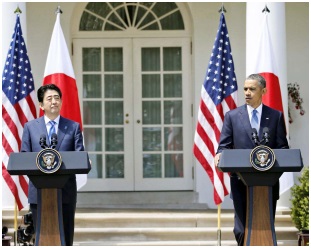Abe and Obama reaffirm they will go ahead with the Henoko relocation

Prime Minister Shinzo Abe and U.S. President Barack Obama held a joint press conference on April 28 at the White House, Washington D.C. (Photograph provided by Kyodo news service.)
April 29, 2015 Sakae Toiyama of Ryukyu Shimpo reports from Washington D.C.
Prime Minister Shinzo Abe and President Barack Obama held a meeting on April 28 at the White House in Washington D.C. In the joint vision statement, the two leaders confirmed they would drive forward with the relocation of U.S. Marine Corp Air Station Futenma to Henoko, Nago. However, the statement does not include the wording that ‘U.S. military operations at the Futenma base will stop within five years’. The former Governor Hirokazu Nakaima approved the landfill application from the central government in 2013, on the basis of just such a verbal promise from the prime minister.
In a joint press conference after the meeting, Obama stated, “Our new guidelines complement our effort to realign U.S. forces across the region, including on Okinawa, in order to lessen the impact of our bases on local communities. And I reaffirmed our commitment to move forward with the relocation of Marines from Okinawa to Guam. ”
Abe said, “The dangers arising from the Futenma Air Station being surrounded by housing and schools should be eliminated by relocation to Henoko as soon as possible. We will move forward with mitigating the impact of the base in Okinawa, founded on a strong relationship of trust between Japan and the United States. ”
The two leaders agreed to strengthen the Japan-U.S. relationship as a means towards building peace in the Asia-Pacific region and the world. The joint statement highlighted ‘a historic step forward in transforming the U.S.-Japan partnership’ in the year which marks 70 years since the end of World War II. It emphasizes cooperation in the fields of security and the economy.
At that meeting, they emphasized the strength of their alliance and confirmed they would further expand cooperation under new guidelines. Japan and the United States have revised the guidelines for the first time in 18 years, defining how defense would be shared between the Japanese Self-Defense Forces (JSDF) and the U.S. forces.
On the realignment of U.S. forces in Japan, Abe is believed to have asked for an acceleration of the implementation of the plan to return U.S. military facilities south of Kadena, and the plan to move U.S. Marines to Guam in an effort to reduce the burden on the Okinawan community. Abe’s intention is to use this argument to convince Governor Takeshi Onaga to accept the Henoko relocation.
The announced joint statement does not include any direct wording regarding the Henoko relocation, but it emphasizes that ‘the United States stands resolute and unwavering in all of its commitments under the U.S.-Japan Security Treaty, based upon a stable, long-term U.S. military presence in Japan. ‘
Ignoring the persistent opposition to the Henoko relocation, the two leaders showed their intentions to advance with the plan.
In the field of security, alluding to China’s rising military power, the two leaders agreed to recognize the importance of the rule of law in maintaining the international order of the seas. They voiced their opposition to any unilateral attempts to change the status quo. In the field of economics, they pledged to quickly conclude talks on the Trans-Pacific Partnership (TPP), which they said will contribute to the growth and prosperity of the Asia-Pacific region.
(English translation by T&CT)
Previous Article:Protest rally against construction of new US military base attracts 2,500 people during Abe’s visit to US
Next Article:“Peace Walk” tour around Battle of Okinawa sites in Urasoe, Naha
[Similar Articles]
- Joint statement does not touch upon Futenma relocation issue
- Heads of Japan, U.S. assert “Henoko is the only solution”, with no mention of pledge to close Futenma
- Henoko not referred to as “the only” option for MCAS Futenma relocation in final NDAA bill
- US Defense Secretary stresses importance of realignment of US forces in Japan, including Henoko relocation
- Relocation of Futenma Air Station:U.S. Defense Secretary urges Japan to move as soon as possible on application procedures for the Henoko landfill
 Webcam(Kokusai Street)
Webcam(Kokusai Street)


